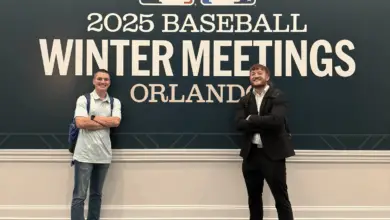
Cubs Prospect Profile: Speed Merchant Fernando Kelli Opening Eyes in Eugene
One thing the Cubs system has lacked in recent years has been speed. One man can’t change that all by himself, but 19-year-old outfielder Fernando Kelli is sure going to do his best.
Last summer, a then 18-year-old Kelli stole 58 bases in the Dominican Summer League. Oh, he hit .320 with an on-base percentage of .437 to go with all that speed. He’d only been seen a little bit during spring training of 2017 and no one knew that much about him before that.
I had a lot of questions about Kelli and was extremely interested to get a good look at him coming into this season. He actually got into a couple games with the big league club and held his own down in Mesa. And now that he plays late at night out in Eugene, MiLB.tv viewers can get a pretty good look at what he can and cannot do.
There are a lot of things to like and there are a lot of things that he needs to improve on. Then again, it’s important to remember that he’s still a teenager for another month and is playing one level above most of his peers.
Things He’s Doing Well
 The first thing you notice about Kelli is his speed. It affects how defensive player field and throw and prevents pitchers from devoting their entire focus to the hitter in the box. He stole seven bases in his first 10 games with the Emeralds, puttin him on pace to steal 50 bag. He has been caught stealing twice and picked off once as he continues to adjust.
The first thing you notice about Kelli is his speed. It affects how defensive player field and throw and prevents pitchers from devoting their entire focus to the hitter in the box. He stole seven bases in his first 10 games with the Emeralds, puttin him on pace to steal 50 bag. He has been caught stealing twice and picked off once as he continues to adjust.
As you might imagine, that elite foot speed also makes Kelli a pretty decent defender. He can really get to some balls in the outfield and already has one assist as he gunned down a runner heading back to first. Kelli is not just a one-trick pony, he’s an all-around baseball player.
I like his hitting profile, too. Despite being only six feet tall and weighing in at 180 pounds (which might be generous), he can hit the ball with authority to right field and has one home run to date. A right-handed batter, he is perfectly comfortable pulling the ball (41 percent to left) and and going oppo (45 percent to right).
He’s also capable of getting it in the air, with 50 percent of his contact being line drives and fly balls. His size and speed often fool defenses into coming in on him at the corners to guard against bunting and he takes advantage of that by lining it over the infielders.
I really like watching him play because there is no one quite like him in the Cubs organization right now and you never know what will happen each time he’s out there.
Things to Work On
It didn’t take teams long to catch on that Kelli has some serious wheels. He got thrown out at second twice in one game and is now learning how far he can lead off and how to pick his spots to steal bases.
He struck out four times in his first eight at-bats and his K rate is still high at 38 percent while his walk rate is at 7.7 percent. Those numbers are going to have to change, as a leadoff hitter simply can’t strike out that often. That’s getting lower, though.
Despite being able to make a really good play in the outfield tracking down a fly ball, there have been moments where he completely loses the ball or takes a poor route. The Eugene outfield is not the easiest place to play because the outfielders are staring directly into a setting sun, but Kelli is going to have to improve in some fundamental areas.
He’s struggling with breaking balls or offspeed stuff down and away, which can seem odd because he takes a fastball to right field with ease. He needs to learn to do the same with those secondary pitches.
Seeing a curve In the US is a lot different than in the DSL, where most of the pitchers are 17-19-year old kids. In the Northwest League, a lot of the arms have some level of college experience. Even the pitchers coming out of high school have much more game experience than kids from the DSL.
It’s an interesting adjustment that sometimes takes two to three years of experience to fully grasp. Kelli will play at Eugene this year, go to fall instructs, and then play winter ball where he will continue to improve over time as he gains experience. Who knows, he might even catch on this season.
He could be a different hitter next spring in South Bend or even as early as mid-July as he improves his pitch recognition skills. It’s all dependent upon on how fast he can adjust. Even as a relatively raw prospect, he’s very exciting. And the best part is that he could become even more so over the next few years.

